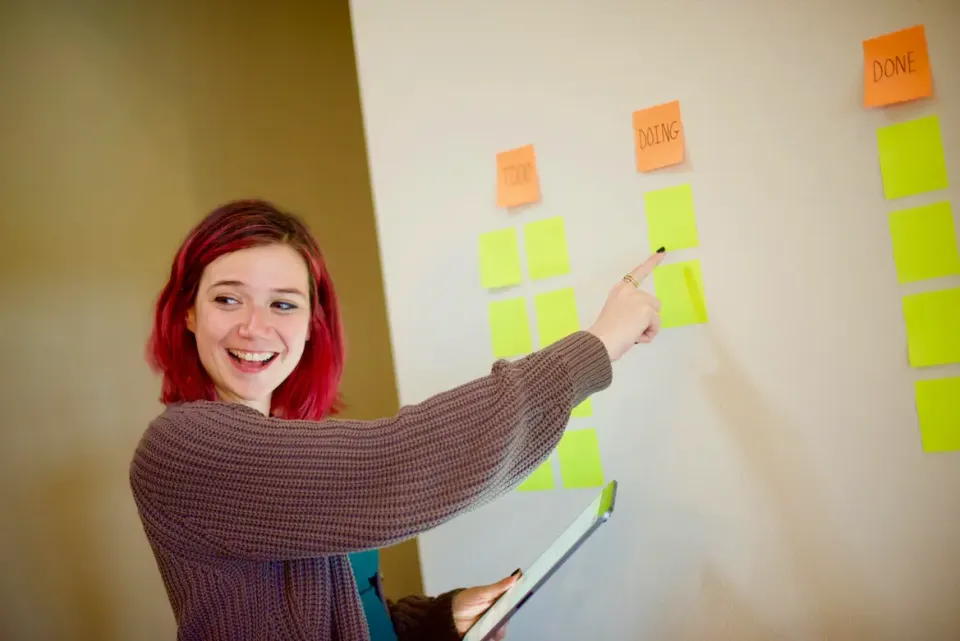Why You Shouldn't Use Scrum. Do This Instead!

Are you tired of Scrum making your team meetings feel like a never-ending episode of The Office? Are you over the constant sprints and stand-ups, leaving you feeling like a hamster on a wheel?
Scrum is fundamentally incompatible with setting up asynchronous processes in your remote team. And failure to setup remote processes means you won’t be able to hire across time zones. Essentially, with Scrum, your team is spending a lot of time in meetings and everyone needs to be online at the same time to join them.
Well, we’ve got some good news for you. There is a better way! That's right, and I'm here to tell you why you shouldn't use Scrum and what you should do instead.
Key Takeaways:
- Scrum means a lot of unnecessary meetings.
- The 2-week framework of scrum doesn’t work for all remote teams.
- Asynchronous collaboration is a better alternative to scrum.
Here’s Why You Shouldn’t Use Scrum
Scrum is a popular project management framework that is widely used in software development and other industries. Many teams have found that it doesn't always work for them. It can be rigid, time-consuming, and often leads to unnecessary bureaucracy.
It isn't the be-all and end-all of project management. Maybe you already know that. Maybe you don’t. But since you’re here, let us help you break free from the monotony of Scrum.
We’ve experienced the challenge of using Scrum in our team. And that’s our motive for writing this article. We’ve found a better way, and we want you to learn the same.
The Challenge of Using Scrum

The Scrum framework appeared to have its own set of challenges. Most people would admit the fact that it slows down work. But it’s also not compatible with all sorts of workplaces out there.
It certainly failed to work with the kind of work style we have. A fully async remote team, like mine, will bleed if the Scrum framework is primarily followed.
And since most of our readers are remote employees and employers operating in an async environment, you will certainly benefit from the alternative I have in this blog post.
The Daunting Meetings
The normal “Scrum meetings” in my teams looked like this:
- 2h for grooming.
- 1h30m for sprint planning.
- 2h30m for stand ups (15m x 10 days).
- 2h for retrospective.
Every team member started a 2-week Sprint with 8 hours in meetings already scheduled. That's two full days of lost productivity, per team member, per month!
And these 8-hour meetings only got extended every Sprint. Because sometimes the scheduled meetings get overrun. Sometimes the leaders follow the proverbial "Let's take this one offline", which usually ends in another meeting.
And sometimes, the other proverbial "Let's book a follow-up to close this off" came into play. Which, again, only meant another unnecessary meeting.
So for one, Scrum wastes your time on unnecessary stuff.
Scrum Hinders the Flow of Async Teams
I started seeing red flags in Scrum when I started implementing asynchronous processes in my teams.
I hired people in different time zones, and forcing them to sit in so many meetings started feeling like a big bottleneck. Because the core of Scrum is the meetings, while the core of async teams is reduced meetings!
So ultimately, Scrum proved to be not compatible with Async.
The Senseless 2-Week Framework
Another thing we don't like in Scrum is how it forces all projects/features into a 2-week framework. Personally, I don’t like this. But at the same time, many teams have found this a feature with no absolute purpose.
Because some features are small and take just a few days. Others are enormous and take longer than two weeks.
So not all types of effort fit well into such a fixed framework.
Reduce Meetings

We know the core of Scrum is the meetings. So before we get into the alternative for Scrum, let’s make sure you take measures to reduce meetings.
Meetings are great. Some people love them, but they're just a necessary evil for the rest of us. Too much of it becomes a barrier at work. That means fewer meetings are essential for productivity.
But don't get me wrong; meetings can be valuable when they are planned and executed correctly. It's all about finding a balance. So next time, before scheduling a meeting, ask yourself, "Is this meeting really necessary? Can this be handled through an email or a quick chat?" Trust me, and your team will thank you for it.
If you come to the point where you think you’re having too many meetings, or your team is complaining the same, consider bringing down the number of meetings. Chances are, you’re already having too many unnecessary meetings. Cut them all down now!
Ways To Cut Down the Number of Meetings
Here are a few ways you can follow to reduce meetings:
- Only call for a meeting if it’s absolutely necessary. Otherwise, just text your team members with a clear message.
- Don’t call for a meeting if the meeting will be uni-directional. Instead, just text your team.
- Before you do have a meeting, establish clear agendas and objectives. This helps you eliminate unnecessary “follow-up” meetings.
- Adopt the culture of documentation so that you don’t always have to rely on meetings to collect/share feedback.
So, What’s the Alternative?

A practical alternative to Scrum is a process crafted with documentation and async collaboration. This is a goal-oriented approach to work, and we’ve found it works exceptionally well for developing software.
“Goal" means a clear business case that supports “Why” such a feature needs to be built. For example, "We need HIPAA compliance to sell to clients in the Healthcare sector.".
Between idea and shipping, there are many activities, such as:
- Create a business case.
- Collect requirements.
- Assess feasibility and tradeoffs.
- Plan/architect the solution.
- Implement.
- Test.
- Launch.
- Retrospect on results.
So we break them into these five critical questions:
- Why: The clear business case.
- What: The feature that will address the business case.
- How: The technical approach to implement that solution.
- Who: The team and resources needed for that effort.
- When: The delivery timeline for expectation alignment.
Now, as an efficient CTO, I’m not the one to bring my entire team into a brainstorming meeting to tackle these questions. That’s just asking for chaos!
Each question depends on different stakeholders, so we can tackle them one by one, just like the pieces of a puzzle.
We start by putting these five questions together in a collaborative document, like a Notion template. Below is a live image of it that I just captured.

Why and What
A business stakeholder or a product manager is usually the first to start working on this document. They define the why. For example, they’ll write about “why are we doing this?”
The product manager then builds up on it to develop the what. For example, this would be about “what exactly are we building?”
It needs to be clear enough so that Engineers understand it but flexible enough to take input around feasibility and implementation tradeoffs.
How, Who, and When
The How, Who, and When are usually collaborative. They’re led by technical stakeholders, e.g., an EM.
Resources or time constraints force us to cut scope. So trade-offs are to be discussed collaboratively.
The how discussion should clarify the tasks to be done. For example, “how do we make it work?”
Then comes the assignee for each of them, which is the who.
Trade-offs regarding the timeline should be clarified, and share expectations about when the project could be completed.
How It Transformed Our Workflow

Before we started using this process, things were a little wild for my teams and me. Me, eight years ago, as a first-time CTO:
- Worked 12+ hours a day.
- Managed my team during the day with clunky processes.
- Coded at night for some deep work.
But, as you can imagine, this led to intense burnout. Plus, the pressure on my teams was insane!
Fast forward to today, things are much different:
- I now work 7-8 hours a day.
- I work in bursts of productivity.
- Manage my team asynchronously.
- Easily fit in deep work during the day.
The result? I'm feeling energized and ready to take on the world! And my teams also get to enjoy the same benefits. I constantly strive to help them transform their lives just like I transformed mine.
This process has truly transformed our workflow, making us more productive, efficient, and happier. It's like a magic spell that turned our work into a well-oiled machine. No more clunky processes or late-night coding sessions, just focused, productive work.
And at the end of the day, that's what it's all about, right? Doing our best work while still having the luxury of life outside of the office.
Conclusion
In conclusion, the traditional method of using scrum to manage your team may seem like you're shouting into the void. With little energy left at the end of each day and no one really benefiting from it, it's not a sustainable approach, especially for async remote teams.
This is where our alternative approach comes into play. By setting clear goals in an asynchronous collaborative environment, we have seen a drastic increase in the productivity of our team.
With clear goals and open communication channels, everyone knows what is expected of them and can work together to achieve the desired outcome. This leads to a more motivated and engaged team, and a more efficient and productive workflow.
So, if you feel like you're tired of shouting into the void, give this alternative approach a try and watch your team soar to new heights.
Follow us for more knowledge about remote work
We'll be publishing new articles every week, and new social media content every day. If you enjoyed this article, follow us on Twitter or Linkedin, and stay in the loop. Share our content and drop us a comment there. Let's help more people learn about remote work.


